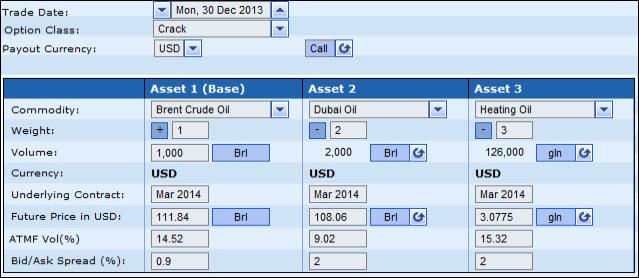
A crack option gives the holder of the option the right to exchange the future price of a base asset for the future price of one or two other assets at a predefined strike.
Who uses a crack option?
A crack option (c) is commonly used by a company which is exposed to the difference (or spread) in the prices of two related commodity futures, rather than to the price of a single commodity future. This generally happens when a company uses one commodity as an input to a process which in turn produces another commodity.
The exposure is to the adverse movements in the value of the input commodity (for example, the price of crude oil inputs) relative to the output commodity (for example, the refined products). It is the difference between the price of the input commodity and the price of the output commodity that is known as a crack spread risk.
Pricing a crack option in SDX Commodities & Energy
You need to define the quantity of the assets to be exchanged. This is defined as an X:Y:Z ratio, also known as a crack ratio. The ratio is subject to the constraint that X is always exchanged for Y + Z together (and the sign of the base asset X is always the inverse of the sign of the other 2 assets, Y and Z). An example of this ratio can be seen in See "Crack ratio defined using Weight fields ", where it is defined using the Weight fields:

Figure 1: Crack ratio defined using Weight fields
To put it simply, a refiner wishing to hedge price exposures will use a crack ratio expressed as X:Y:Z, where X represents a number of barrels of crude oil, Y represents a number of barrels of Dubai oil and Z represents a number of barrels of heating oil. This crack ratio is used for hedging purposes by buying X barrels of crude oil and selling Y barrels of Dubai oil and Z barrels of heating oil in the futures market.
The crack option derives its value from the difference between the prices of the two (or three) underlyings. These underlyings can be either the asset's future price, its swap rate, or both. If it is an exchange-listed option, the underlying is the asset's future; if it's an OTC option, the underlying is the asset's swap rate.
In SDX Commodities & Energy, choose a crack option if you want an option on the spread between 2 (or 3) exchange traded futures. However, if you want an option on the spread between the assets’ swap prices, you will need to enter into a Spread Option .
An example of an exchange-listed crack option is the (3:2:1) NYMEX Division crack spread. This comprises the simultaneous purchase and sale of crude oil and petroleum products futures. The contract contains 3 crude oil futures contracts exchanged for both of the following–2 gasoline futures contracts and 1 heating oil futures contract. It allows a refiner to lock in the differential between refinery input and output prices, and profit from or protect against changes in that value.
For each crack ratio, once you have input the tenor, the assets and the weight of each asset, the system can then display the forward crack spread. This value reflects the spread obtained by trading the defined assets according to this ratio. That is, the forward crack spread is the future cost of one unit of crack (i.e., the cost of exchanging the base asset with the other assets) on the expiry date.
When defining the option you define a strike. On the expiry date, if the holder of the option exercises it, the strike is the amount to be paid for each defined unit of crack, in addition to the exchange of the asset underlyings. That is, if the strike is 35 USD, on the expiry date in addition to the exchange of the asset underlyings, for each unit defined 35 USD will also be exchanged.
The strike can be any number, including a negative integer or 0 (zero). If the strike is defined as 0, the instrument is known as an exchange option, and on the expiry date there is simply a straight exchange of the asset underlyings.